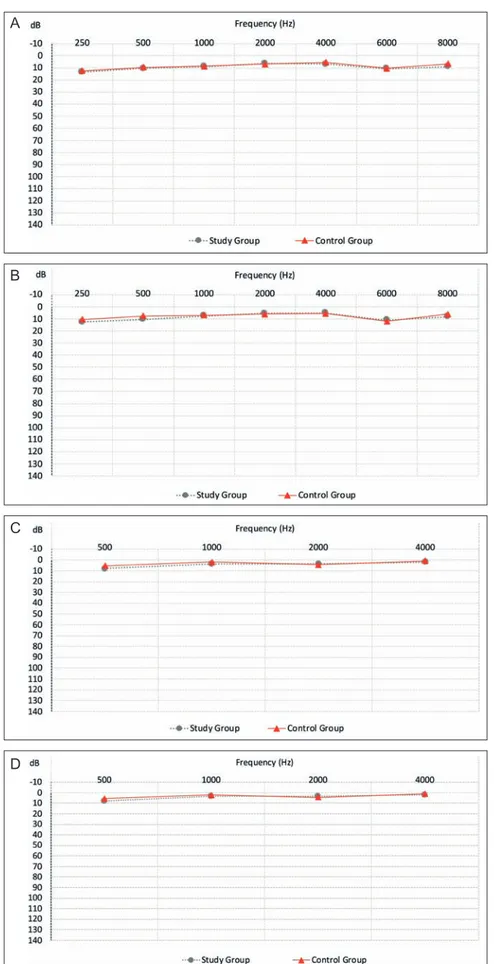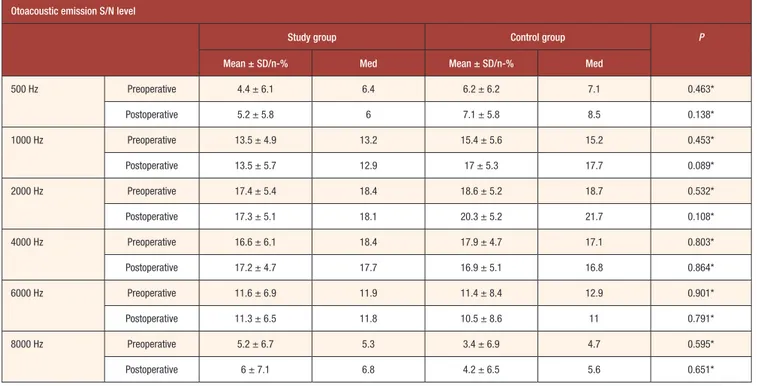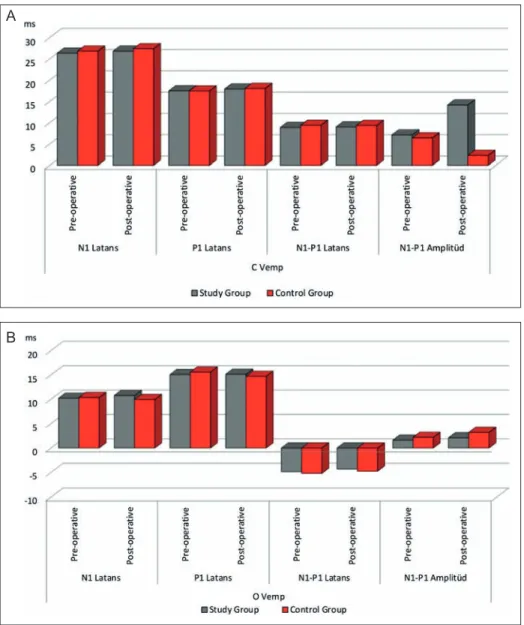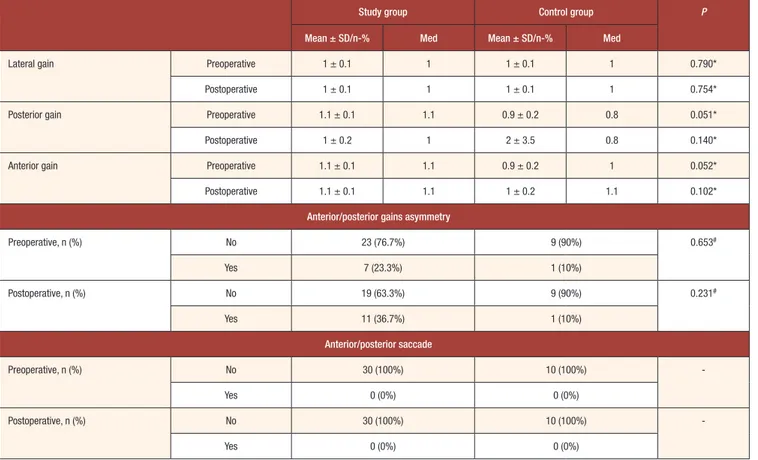Aesthetic Surgery Journal 2018, Vol 38(11) 1172–1177 © 2018 The American Society for Aesthetic Plastic Surgery, Inc. Reprints and permission: journals.permissions@oup.com DOI: 10.1093/asj/sjy117 www.aestheticsurgeryjournal.com Rhinoplasty
Effects of Rhinoplasty on Labyrinthine
Function
Ahmet Mahmut Tekin, MD; Erkan Soylu, MD;
Handan Turan Dizdar, PhD Candidate; Fahrettin Yılmaz, MD; and
Yildirim Ahmet Bayazit, MD
Abstract
Background: Rhinoplasty is a common surgical procedure that is requested and accepted by patients for cosmetic and functional reasons. Osteotomies are performed on nasal bone, maxillary crest, or vomer to fix the deviations of the nasal dorsum or septum. During the percussion of the osteotomes with the surgical mallet, the vibration energy diffuses to the cranium. Auditory and vestibular systems may be affected by these vibrations. Objectives: To assess the effects of rhinoplasty, in which osteotomies were performed using a hammer, on the audiovestibular system.
Methods: Thirty adults who underwent rhinoplasty were included in the study group. Ten age and gender matched adults who had nasal surgery without surgical mallet or osteotome served as the control group. The patients in both groups were assessed using pure tone audiometry, tympanometry, distortion product otoacoustic emission testing, and vestibular-evoked myogenic potential, as well as video head impulse tests (vHIT) before the operation and 1 week after the operation.
Results: On auditory assessment, there was no significant difference between the study and control groups regarding pure tone thresholds at frequen-cies of 250 Hz to 8 kHz (P > 0.05) as well as otoacoustic emissions. The vestibular assessment performed by using vestibular-evoked myogenic potential and vHIT did not reveal a statistically significant difference between the groups, before surgery or after surgery (P > 0.05).
Conclusions: Rhinoplasty appears to be a safe operation in terms of audiovestibular functions, and osteotomy, in which a hammer is usually used, does not have an impact on hearing or balance functions of the ear.
Level of Evidence: 2
Editorial Decision date: April 26, 2018; online publish-ahead-of-print May 11, 2018.
According to data gathered by the American Society for Aesthetic Plastic Surgery (ASAPS), rhinoplasty is one of the most common cosmetic surgery procedures, with over 140,000 procedures performed in 2016.1 Osteotomies are performed
on nasal bone, maxillary crest, or vomer to fix the deviations of the nasal dorsum or septum. During the percussion of the osteotomes with the surgical mallet, the vibration energy dif-fuses to the cranium. Auditory and vestibular system organs located in the temporal bone are affected by these vibrations.
Conditions affecting the inner ear, such as vestibular and cochlear fractures, bleeding in the inner ear, and dam-age of the cochleovestibular nerve manifest with vestibu-lar and audiological symptoms.2 Radiological assessment
usually fails to identify these sorts of damages to the laby-rinth in patients complaining of audiovestibular symptoms after head trauma. The underlying mechanism in these Dr Tekin is a Consultant of Otorhinolaryngology, Department of Otorhinolaryngology, Bilecik State Hospital, Bilecik, Turkey. Dr Soylu is an Associate Professor of Otorhinolaryngology, and Dr Yılmaz and Dr Bayazit are Professors of Otorhinolaryngology, Department of Otorhinolaryngology, Istanbul Medipol University. Mrs Turan Dizdar is an Audiologist, Department of Audiology, Istanbul Biruni University.
Corresponding Author:
Dr Ahmet Mahmut Tekin, Ertugrulgazi Mah, Yediler Cad No:4/28, 11040 Bilecik, Turkey.
E-mail: drtekinahmet@gmail.com; Twitter: @drtekinahmet
A
B
C
D
Figure 1. (A) Comparison of preoperative air conduction, (B) comparison of postoperative air conduction, (C) comparison of preoperative bone conduction, and (D) comparison of postoperative bone conduction.
1174 Aesthetic Surgery Journal 38(11)
patients is commonly assumed to be the concussion of the labyrinth, which is common after head trauma.3
Concussion of the labyrinth is defined as a sensorineural hearing loss that may accompany vestibular symptoms as a result of the reflection of intense pressure to the ear with-out an open labyrinth fracture after trauma.4 Sensorineural
hearing loss is characterized by high-frequency hearing loss that notches in the 4 kHz to 6 kHz range, like acoustic trauma.5 In brief, concussion of the labyrinth may affect
auditory and vestibular functions.6
To the best of our knowledge, there is no prospective or case control study in the literature in English in which the effects of rhinoplasty on audiovestibular functions were assessed. In this study, we aimed to illuminate whether rhinoplasty surgeries in which osteotomies were used would impact labyrinthine functions.
METHODS
The study was approved by the Istanbul Medipol University ethical committee. Forty patients who were operated on in our department between September and December 2015 were included in the study. Thirty patients who under-went rhinoplasty were included in the study group, and 10 patients who underwent nasal surgery without a surgical mallet or osteotome comprised the control group. A rand-omization technique was used by including patients who underwent operations on the second and fourth days of every week. Excluded were any patients who had a history
of dizziness, ototoxicity, chronic systemic disease, head trauma, ear surgery, cervical disc problem, or any other problem such as anatomical morphological variations, which might impact audiovestibular functions. We per-formed preoperative nasal endoscopy on all patients to reveal such problems.
The patients in the study group had been admitted to the hospital due to difficulty in breathing, nasal deformity, and septal deviation. They all underwent an open rhino-plasty procedure. In surgery, after local lidocaine infiltra-tion under general anesthesia, the nasal dorsum skin was elevated via mid-columellar V incision. The nasal dorsum was exposed via incision and elevation of the perios-teum. Septal defects were repaired via a dorsal approach. Cartilage grafts suitable to the pathologies in the nasal dor-sum were used. The dordor-sum was shaped by performing bilateral median and lateral osteotomies. The procedure was completed by bandaging and applying an external thermal splint and a silicone tampon after the surgery.
The patients in the control group had no deformity or problem in their nasal bones, and underwent nasal sur-geries without osteotomy, such as endoscopic endonasal sinus surgery (n = 6), inferior turbinate (n = 2), and nasal columellar reduction (n = 2) surgery.
A total of 80 ears of the 40 patients were tested. Audiovestibular assessments were performed in both groups 2 hours before and 1 week after the surgeries. As our goal was to reveal the early impacts of osteotomy on audio-vestibular functions, we did not add further assessments. Table 1. Results of Otoacoustic Emission
Otoacoustic emission S/N level
Study group Control group P
Mean ± SD/n-% Med Mean ± SD/n-% Med
500 Hz Preoperative 4.4 ± 6.1 6.4 6.2 ± 6.2 7.1 0.463* Postoperative 5.2 ± 5.8 6 7.1 ± 5.8 8.5 0.138* 1000 Hz Preoperative 13.5 ± 4.9 13.2 15.4 ± 5.6 15.2 0.453* Postoperative 13.5 ± 5.7 12.9 17 ± 5.3 17.7 0.089* 2000 Hz Preoperative 17.4 ± 5.4 18.4 18.6 ± 5.2 18.7 0.532* Postoperative 17.3 ± 5.1 18.1 20.3 ± 5.2 21.7 0.108* 4000 Hz Preoperative 16.6 ± 6.1 18.4 17.9 ± 4.7 17.1 0.803* Postoperative 17.2 ± 4.7 17.7 16.9 ± 5.1 16.8 0.864* 6000 Hz Preoperative 11.6 ± 6.9 11.9 11.4 ± 8.4 12.9 0.901* Postoperative 11.3 ± 6.5 11.8 10.5 ± 8.6 11 0.791* 8000 Hz Preoperative 5.2 ± 6.7 5.3 3.4 ± 6.9 4.7 0.595* Postoperative 6 ± 7.1 6.8 4.2 ± 6.5 5.6 0.651*
* Mann-Whitney U test; med, median
Pure tone audiometry (PTA), tympanometry, and distortion product otoacoustic emission testing (DPOAE) were used to assess the auditory functions. Vestibular-evoked myogenic potentials (VEMP) and a video head impulse test (vHIT) were used to assess vestibular functions (AC-40 audiome-ter, Titan, Eclipse EP 25 and EyeSeeCam, Interacoustics).
On audiometry, air, and bone conduction thresholds at the frequencies of 250 Hz to 8000 Hz were measured. DPOAEs were recorded at the frequencies of 500 to 8000 Hz. The VEMP testing included cervical VEMP (cVEMP) and ocular VEMP (oVEMP); and N1 latency, P1 latency, N1-P1 latency, and N1-P1 amplitude were recorded. Gain asymmetries, sac-cades, and semicircular canals were evaluated using vHIT.
SPSS 22.0 software was used to analyze the data. The distribution of the variables was measured by using the Kolmogorov-Smirnov test. The Mann-Whitney U test was used to analyze quantitative data. The Wilcoxon sign test
was used to analyze repetitive measurements. The Chi-square test was performed to analyze qualitative data, and Fisher’s exact test was used when the test conditions did not meet the assumptions. A P value less than 0.05 was accepted as statistically significant.
RESULTS
There were 14 men and 16 women aged between 21 and 50 years old (mean, 31 years) in the study group, and there were 5 men and 5 women aged between 20 and 45 years (mean, 29 years) in the control group. There was no statis-tically significant difference in patient numbers or demo-graphic features of the patients between the study and control groups (P > 0.05).
On pure tone audiometry, preoperative and postoper-ative pure tone thresholds of the patients in both groups
A
B
Figure 2. (A) Comparison of the results of cVEMP and (B) comparison of the results of oVEMP.
1176 Aesthetic Surgery Journal 38(11)
were not significantly different at the frequencies tested (P > 0.05). There was no significant difference between the pure tone thresholds of the patients and controls as well (P > 0.05) (Figure 1).
On DPOAE testing, preoperative and postoperative DPOAE test results of the patients in both groups were not significantly different at the frequencies tested (P > 0.05). There was no significant difference between the DPOAEs of the patients and controls as well (P > 0.05) (Table 1).
On cVEMP and oVEMP testings, preoperative and post-operative N1, P1, and N1-P1 latencies, and N1-P1 ampli-tudes of the patients in both groups were not significantly different (P > 0.05). There was also no significant differ-ence between the VEMP values of the patients and con-trols (P > 0.05) (Figure 2).
On vHIT testing, preoperative and postoperative gains of the patients in both groups were not significantly different (P > 0.05). There was also no significant dif-ference between the gains of the patients and controls (P > 0.05) (Table 2).
DISCUSSION
The effect of maxillofacial or dental surgeries on inner ear functions has been debated because some patients who
underwent these sorts of interventions complained of dizziness or hearing problems. However, the information is limited to a few cases reported to date. Two possible mechanisms have been proposed to explain the inner ear symptoms of the patients who had maxillofacial or dental intervention. One is the transmission of mechanical vibra-tions to the inner ear, and the other is the hyperextension of the neck during general anesthesia.7,8
In maxillofacial and dental procedures, vibrations cre-ated during osteotomies or drilling are transmitted to the labyrinth, which may lead to inner ear trauma.7-10 In
addi-tion, lying down in the supine position with the head and neck hyperextended during surgery and the noise generated by the drill may negatively affect the inner ear.9 However,
there is no objective evidence of either of these contentions. Rhinoplasty has been a common surgery worldwide, and osteotomy has been an important step in the surgical procedure. There are different techniques of nasal oste-otomy in rhinoplasty, such as percutaneous and internal osteotomy, which are widely used conventional tech-niques based on mechanical energy.11 Piezo is a relatively
new technique using piezoelectric micrometric ultrasonic vibrations for making bone incisions.12 However, it is not
evident whether rhinoplasty will lead to inner trauma due to transmission of vibrational energy.
Table 2. Results of vHIT
Study group Control group P
Mean ± SD/n-% Med Mean ± SD/n-% Med
Lateral gain Preoperative 1 ± 0.1 1 1 ± 0.1 1 0.790*
Postoperative 1 ± 0.1 1 1 ± 0.1 1 0.754*
Posterior gain Preoperative 1.1 ± 0.1 1.1 0.9 ± 0.2 0.8 0.051*
Postoperative 1 ± 0.2 1 2 ± 3.5 0.8 0.140*
Anterior gain Preoperative 1.1 ± 0.1 1.1 0.9 ± 0.2 1 0.052*
Postoperative 1.1 ± 0.1 1.1 1 ± 0.2 1.1 0.102*
Anterior/posterior gains asymmetry
Preoperative, n (%) No 23 (76.7%) 9 (90%) 0.653# Yes 7 (23.3%) 1 (10%) Postoperative, n (%) No 19 (63.3%) 9 (90%) 0.231# Yes 11 (36.7%) 1 (10%) Anterior/posterior saccade Preoperative, n (%) No 30 (100%) 10 (100%) -Yes 0 (0%) 0 (0%) Postoperative, n (%) No 30 (100%) 10 (100%) -Yes 0 (0%) 0 (0%)
* Mann-Whitney U test; # Ki-kare test; med, median
In this study, objective audiovestibular tools helped us to evaluate the impact of rhinoplasty on the inner ear func-tions. The frequency specific audiological assessment up to 8 kHz did not reveal any effect of rhinoplasty on hear-ing. In addition, there was not even a subtle or subclinical effect of rhinoplasty on hearing as evidenced by DPOAE testing.
To date, there have been only a few cases in which patients had dizziness after rhinoplasty, and they were treated with repositioning maneuvers.13,14 Still, the
objec-tive data are lacking regarding the effect of rhinoplasty on labyrinthine functions and association with dizziness. At this point, VEMP and vHIT are helpful. VEMP has been an important diagnostic tool to test the otolith organs.15-18
Measurement of vestibulo-ocular reflex (VOR) gains by vHIT helps to evaluate the semicircular canals in the inner ear.19 In our study, all patients were evaluated objectively
using VEMP and vHIT tests. Our study is one of the studies in the literature encompassing a relatively higher patient number in evaluation of auditory and vestibular functions in rhinoplasty, and it is the only study in the literature using vHIT for this purpose.
According to findings of this study, osteotomy during rhinoplasty has no impact on inner ear or vestibular func-tions nor is associated with the occurrence of dizziness. However, the relatively small number of patients is a lim-itation of this study. Randomized controlled studies with large patient groups are needed to address this question more thoroughly.
CONCLUSION
Outcomes of our study show that osteotomy during rhi-noplasty does not negatively affect audiologic or vestib-ular functions. Randomized controlled studies with large patient groups are needed to address this question more thoroughly.
Disclosures
The authors declared no potential conflicts of interest with respect to the research, authorship, and publication of this article.
Funding
The authors received no financial support for the research, authorship, and publication of this article.
REFERENCES
1. Cosmetic surgery national data bank statistics. Aesthet Surg J. 2017;37(suppl 2):1-29.
2. Fitzgerald DC. Head trauma: hearing loss and dizziness. J Trauma. 1996;40(3):488-496.
3. Mohd Khairi MD, Irfan M, Rosdan S. Traumatic head injury with contralateral sensorineural hearing loss. Ann Acad Med Singapore. 2009;38(11):1017-1018.
4. Canalis RF, Lambert PR. The ear comprehensive otology. Philadelphia, PA: Lippincott Williams & Wilkins; 2000. 5. Sakallıoğlu Ö, Polat C, Soylu E, Orhan İ, Altınsoy H.
Contralateral profound hearing loss after head trauma: a case report. Turk Arch Otolaryngol. 2011;49(3):58-60. 6. Chiaramonte R, Bonfiglio M, D’Amore A, Viglianesi A,
Cavallaro T, Chiaramonte I. Traumatic labyrinthine con-cussion in a patient with sensorineural hearing loss. Neuroradiol J. 2013;26(1):52-55.
7. Kim MS, Lee JK, Chang BS, Um HS. Benign paroxysmal positional vertigo as a complication of sinus floor eleva-tion. J Periodontal Implant Sci. 2010;40(2):86-89.
8. Saker M, Ogle O. Benign paroxysmal positional vertigo subsequent to sinus lift via closed technique. J Oral Maxillofac Surg. 2005;63(9):1385-1387.
9. Özbal Koç EA, Deniz K, Erbek S. Vestibular-evoked myo-genic potentials before and after dental implant surgery. Kulak Burun Bogaz Ihtis Derg. 2015;25(6):337-342. 10. Chiarella G, Leopardi G, De Fazio L, Chiarella R, Cassandro
C, Cassandro E. Iatrogenic benign paroxysmal positional ver-tigo: review and personal experience in dental and maxillo-fa-cial surgery. Acta Otorhinolaryngol Ital. 2007;27(3):126-128. 11. Tirelli G, Tofanelli M, Bullo F, Bianchi M, Robiony M.
External osteotomy in rhinoplasty: piezosurgery vs oste-otome. Am J Otolaryngol. 2015;36(5):666-671.
12. Koçak İ, Doğan R, Gökler O. A comparison of piezosur-gery with conventional techniques for internal osteotomy. Eur Arch Otorhinolaryngol. 2017;274(6):2483-2491. 13. Persichetti P, Di Lella F, Simone P, et al. Benign
paroxys-mal positional vertigo: an unusual complication of rhino-plasty. Plast Reconstr Surg. 2004;114(1):277-278.
14. Koc EA, Koc B, Eryaman E, Ozluoglu LN. Benign par-oxysmal positional vertigo following septorhinoplasty. J Craniofac Surg. 2013;24(1):e89-e90.
15. Tribukait A, Brantberg K, Bergenius J. Function of sem-icircular canals, utricles and saccules in deaf children. Acta Otolaryngol. 2004;124(1):41-48.
16. Valente M. Maturational effects of the vestibular system: a study of rotary chair, computerized dynamic posturogra-phy, and vestibular evoked myogenic potentials with chil-dren. J Am Acad Audiol. 2007;18(6):461-481.
17. Picciotti PM, Fiorita A, Di Nardo W, Calò L, Scarano E, Paludetti G. Vestibular evoked myogenic potentials in children. Int J Pediatr Otorhinolaryngol. 2007;71(1):29-33. 18. Welgampola MS, Colebatch JG. Characteristics and clin-ical applications of vestibular-evoked myogenic poten-tials. Neurology. 2005;64(10):1682-1688.
19. Hale T, Trahan H, Parent-Buck T. Evaluation of the patient with dizziness and balance disorders. In: Handbook of Clinical Audiology. 7th ed. New York, NY: Wolters Kluwer Health; 2014:399-424.



